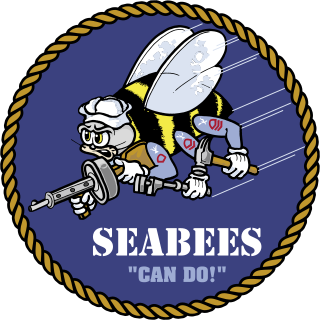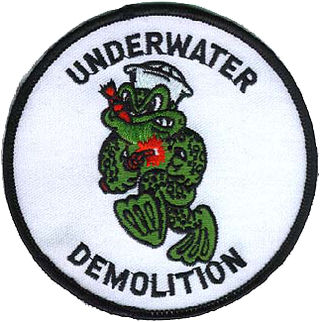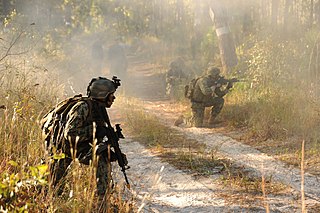
United States Naval Construction Battalions, better known as the Navy Seabees, form the U.S. Naval Construction Force (NCF). The Seabee nickname is a heterograph of the initial letters "CB" from the words "Construction Battalion". Depending upon context, "Seabee" can refer to all enlisted personnel in the USN's occupational field 13 (OF-13), all personnel in the Naval Construction Force (NCF), or Construction Battalion. Seabees serve both in and outside the NCF. During World War II they were plank-holders of both the Naval Combat Demolition Units and the Underwater Demolition Teams (UDTs). The men in the NCF considered these units to be "Seabee". In addition, Seabees served as elements of Cubs, Lions, Acorns and the United States Marine Corps. They also provided the manpower for the top secret CWS Flame Tank Group. Today the Seabees have many special task assignments starting with Camp David and the Naval Support Unit at the Department of State. Seabees serve under both Commanders of the Naval Surface Forces Atlantic/Pacific fleets as well as on many base Public Works and USN diving commands.
In the United States Navy, officers have various ranks. Equivalency between services is by pay grade. United States Navy commissioned officer ranks have two distinct sets of rank insignia: On dress uniform a series of stripes similar to Commonwealth naval ranks are worn; on service khaki, working uniforms, and special uniform situations, the rank insignia are identical to the equivalent rank in the US Marine Corps.

The Underwater Demolition Team (UDT), or frogmen, were amphibious units created by the United States Navy during World War II with specialized non-tactical missions. They were predecessors of the navy's current SEAL teams.
The Submarine Warfare Insignia are worn by qualified submariners.

The Fleet Marine Force Ribbon, officially the Navy Fleet Marine Force Service Ribbon, was a military award of the United States Navy established in 1984 by Secretary of the Navy, John F. Lehman, Jr. The service ribbon was awarded to eligible Navy personnel serving with the Marine Corps between 1984 and 2006. The award signified the acquisition of specific professional skills, knowledge and military experience that resulted in qualifications above those normally required of Navy personnel serving with the Fleet Marine Force (FMF). The FMF Ribbon was discontinued in the mid-2000s due to the promulgation of the FMF badges.
The Fleet Marine Force Warfare Insignia, also known as the Fleet Marine Force badge or FMF pin, are three military badges of the United States Navy which are issued to those U.S. Navy officers and sailors who are trained and qualified to perform duties in support of the United States Marine Corps. There are currently three classes of the Fleet Marine Force pin, being that of enlisted, officer, and chaplain.

The surface warfare insignia is a military badge of the United States Navy which is issued to U.S. Navy personnel who are trained and qualified to perform duties aboard United States surface warships. There are presently four classes of the surface warfare pin, being that of line, staff, special operations, and enlisted. The line and enlisted surface warfare badges may be earned by United States Coast Guard personnel assigned to Navy commands. The various badge types are as follows:

The Small Craft Insignia is a military award of the United States Navy.
The Naval Aviation Supply Corps insignia is a military badge of the United States Navy which is awarded to Naval Aviation Supply Officers (NASOs) of the Navy Supply Corps who have qualified for duties as a Supply Officer in support of naval aviation and are also qualified to serve in duty assignments onboard aircraft carriers. The Aviation Supply Corps insignia is one of four warfare badges issued to Supply Corps officers by the U.S. Navy. The others are the Navy Expeditionary Supply Corps Officer Badge, Surface Warfare Supply Badge, and the Submarine Supply Corps Badge.
The Enlisted Aviation Warfare Specialist (EAWS) insignia is a military badge of the United States Navy which was created in March 1980. The insignia recognizes those members of the Navy's enlisted force who have acquired the specific professional skills, knowledge, and military experience that result in qualification for service in the aviation activities of the Navy. This includes most personnel who are trained flight deck personnel onboard aircraft carriers, or maintenance personnel at an Aircraft Intermediate Maintenance Detachment or Department (AIMD) or aircraft squadron.

The Integrated Undersea Surveillance System breast insignia is a military badge of the United States Navy which was officially created by OPNAVINST 1020.5 on 24 December 1990. The insignia is awarded to those personnel who have been trained and qualified in naval sonar and undersea surveillance technology.

Insignias and badges of the United States Navy are military badges issued by the United States Department of the Navy to naval service members who achieve certain qualifications and accomplishments while serving on both active and reserve duty in the United States Navy. Most naval aviation insignia are also permitted for wear on uniforms of the United States Marine Corps.
The Aircrew Badge, commonly known as Wings, is a qualification badge of the United States military that is awarded by all five branches of armed services to personnel who serve as aircrew members on board military aircraft. The badge is intended to recognize the training and qualifications required by aircrew of military aircraft. In order to qualify as an aircrew member and receive the Aircrew Badge, such personnel typically undergo advanced training in aircraft in-flight support roles.

A United States Navy diver refers to a service personnel that may be a restricted fleet line officer, civil engineer corps (CEC) officer, Medical Corps officer, or an enlisted who is qualified in underwater diving and salvage. Navy divers serve with fleet diving detachments and in research and development. Some of the mission areas of the Navy diver include: marine salvage, harbor clearance, underwater ship husbandry and repair, submarine rescue, saturation diving, experimental diving, underwater construction and welding, as well as serving as technical experts to the Navy SEALs, Marine Corps, and Navy EOD diving commands.

The EXW qualification is a warfare qualification awarded to enlisted United States Navy personnel assigned to U.S. Navy expeditionary combat units, who satisfactorily complete the required qualification course and pass a qualification board hearing. The program was approved July 31, 2006 by then-Chief of Naval Operations Adm. Michael Mullen.

The Civil Engineer Corps (CEC) is a staff corps of the United States Navy. CEC officers are professional engineers and architects, acquisitions specialists, and Seabee Combat Warfare Officers who qualify within Seabee units. They are responsible for executing and managing the planning, design, acquisition, construction, operation, and maintenance of the Navy's shore facilities. The Civil Engineer Corps is under the command of the Chief of Civil Engineers and Commander, Naval Facilities Engineering Systems Command. On 12 August 2022, RADM Dean VanderLey relieved RADM John W. Korka, becoming the 46th commander of NAVFAC and Chief of Civil Engineers.

The US employs divers in several branches of the armed forces, including the navy, army, marines, air force and coast guard.
The Enlisted Information Warfare Specialist Insignia (EIWS) is a military badge of the United States Navy which was created in 2010. The insignia recognizes those members of the Navy's enlisted force who have acquired the specific professional skills, knowledge, and military experience that result in qualification for service in the information warfare activities of the Navy.

Underwater Construction Teams (UCT) are the United States Navy Seabees' underwater construction units numbered 1 and 2 that were created in 1974. A team is composed of divers qualified in both underwater construction and underwater demolition. Possible tasks can be: battle damage repairs, structural inspections and assessments, demolition of waterline facilities or submerged obstructions, installation of submerged surveillance systems, or harbor and channel clearance. As needed, teams may test and or evaluate new or existing aquatic systems or equipment. Extending construction, whether vertical or horizontal, beyond the shoreline and waterline is their specialty. Reflecting Seabee tradition, teams are expected to execute underwater construction anywhere, anytime, under any conditions.













